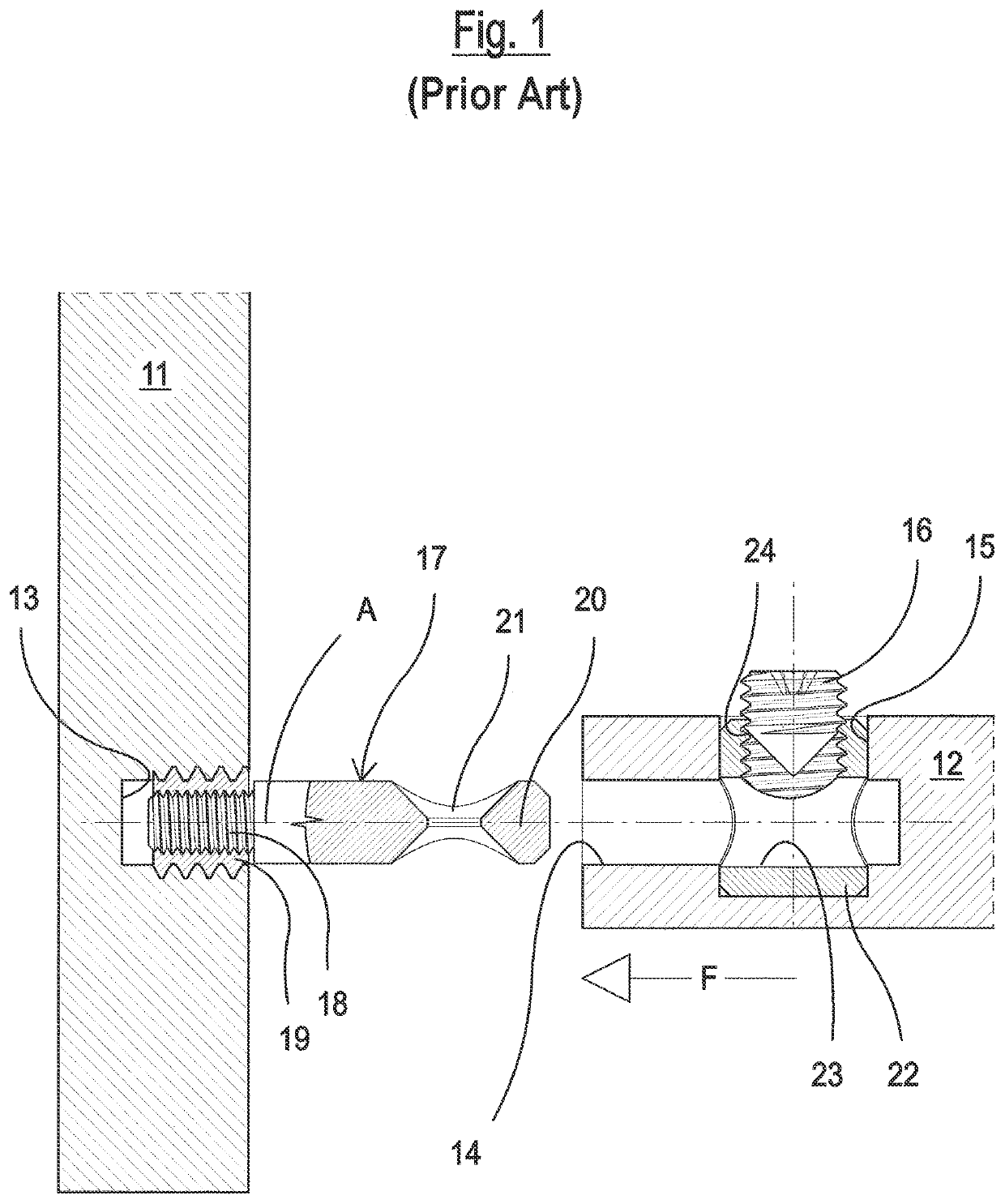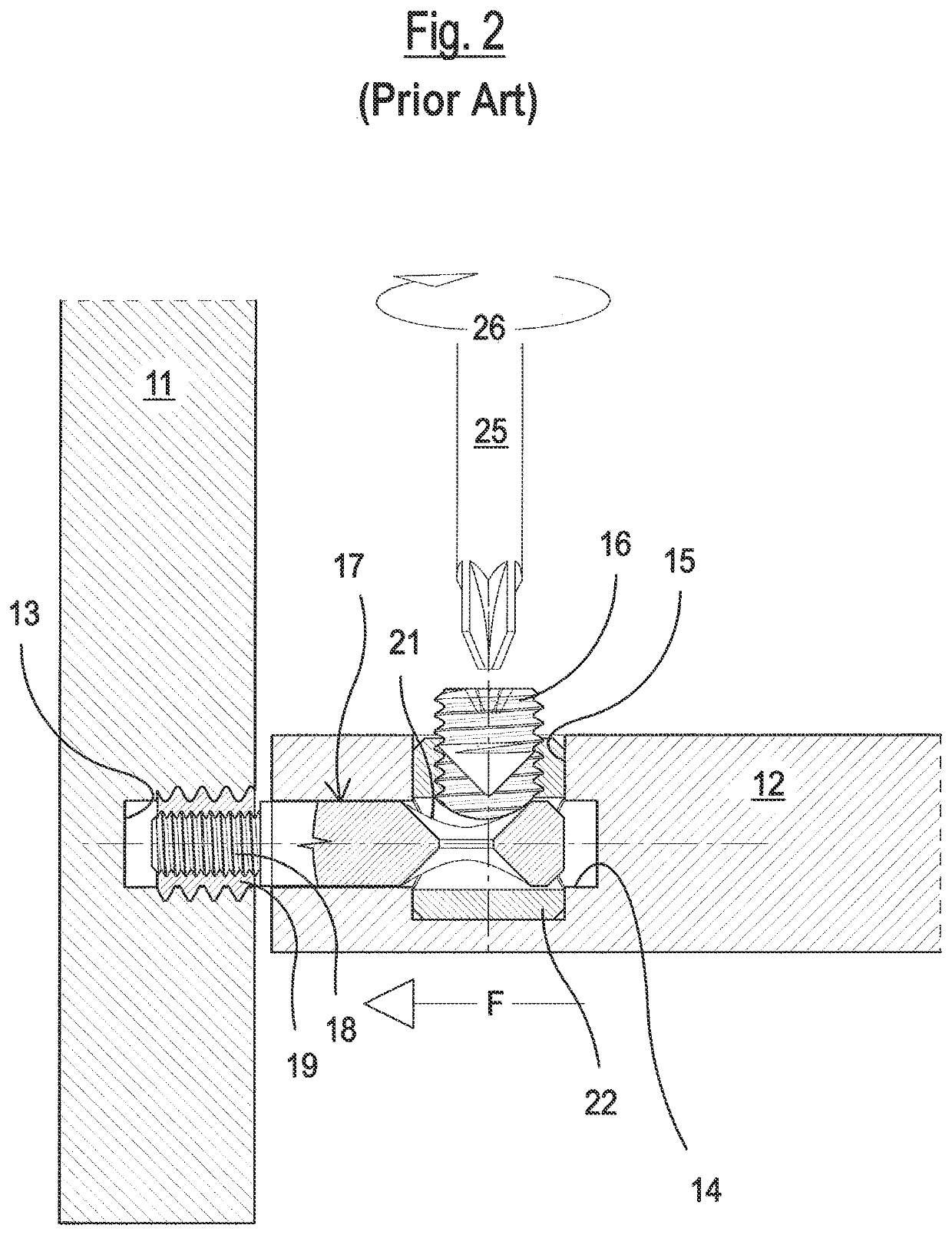Joining device with minimum visibility for parts of furniture and furnishing items
a technology of a jointing device and a minimum visibility, which is applied in the directions of furniture joining, mechanical equipment, fastening means, etc., to achieve the effect of simple, economical and particularly functional manner
- Summary
- Abstract
- Description
- Claims
- Application Information
AI Technical Summary
Benefits of technology
Problems solved by technology
Method used
Image
Examples
first embodiment
[0042]With reference first of all to FIGS. 4, 5 and 6, these show a joining device for parts of furniture and furnishing items according to the invention. In the example, the joining device must connect and join a first panel 11, for example a shoulder 11 of a piece of furniture and a second panel 12, for example a base 12, or in any case a panel or shelf, partially shown in the figures. As illustrated in the examples, the shoulder 11 and the base or panel 12 are generally perpendicular to each other but they may also be tilted with respect to each other.
[0043]The base 12 contains, at one of its ends, a seat S2 in the form of a horizontal blind hole 30 in which an internally threaded bush 31 is positioned for receiving a threaded end 32 of a pin 33.
[0044]In its protruding part, the pin 33 provides a housing 34 for the tip of a blocking bead 35.
[0045]Said pin 33 defines a connection group GC to be firmly blocked for stably interconnecting said shoulder 11 and said base 12, as explain...
second embodiment
[0059]FIGS. 7a and 9b are a raised sectional view and a sectional view from above of a joining device of the invention in a
[0060]Whereas in the first embodiment, a bevel gear was used, in this second embodiment, the joining is obtained by means of a cam for blocking the shoulder 11 and base 12 of a piece of furniture, partially shown.
[0061]The base 12 comprises a seat S2 in the form of a horizontal blind hole 30 in which an internally threaded bush 31 is block-positioned for receiving a threaded end 32 of a screw having an enlarged head 50, in the example, flared.
[0062]The shoulder 11 comprises a seat S1 in the form of a vertical blind hole 36 which intersects with a first and a second horizontal blind hole 37, 38, spaced from each other.
[0063]A cylinder 51 is housed in the vertical hole 36, which rotates in the vertical hole 36. The cylinder 51 provides, in an intermediate portion, a cam 52 suitable for being engaged with the screw having an enlarged head 50 positioned integral wit...
fourth embodiment
[0084]FIGS. 13 to 16 show, in sectional and perspective views, a joining device for parts of furniture and furnishing items, very similar to that of FIGS. 9 to 12.
[0085]In this further example, the same elements are indicated with the same reference numbers.
[0086]In this example, it can be observed that a seat S1 in the form of a vertical blind hole 36 is provided in the shoulder 11, which intersects with a single enlarged horizontal blind hole 137 in substitution of the two holes 37 and 38 of the previous examples.
[0087]Also in this example, a cylinder 61 is housed in the elongated vertical hole 36, in which a pass-through hole 62 is provided in an intermediate portion, which is perpendicular to the axis of the cylinder 61 and suitable for receiving the pin 133. An upper portion of the cylinder 61 contains a further hole 63 produced according to a tilted direction with respect to the axis of the cylinder 61, directed downwards towards the intermediate portion of the cylinder 61.
[00...
PUM
 Login to View More
Login to View More Abstract
Description
Claims
Application Information
 Login to View More
Login to View More - R&D
- Intellectual Property
- Life Sciences
- Materials
- Tech Scout
- Unparalleled Data Quality
- Higher Quality Content
- 60% Fewer Hallucinations
Browse by: Latest US Patents, China's latest patents, Technical Efficacy Thesaurus, Application Domain, Technology Topic, Popular Technical Reports.
© 2025 PatSnap. All rights reserved.Legal|Privacy policy|Modern Slavery Act Transparency Statement|Sitemap|About US| Contact US: help@patsnap.com



